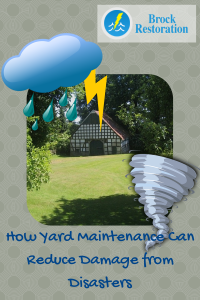How Yard Maintenance Can Reduce Damage from Disasters
 Sometimes reducing the risks of storm damages comes down to doing small, routine things like maintaining your yard. Severe weather can cause serious property damage from yard debris and disasters ranging from hurricane winds to wildfires can cause widespread damages are a result of debris throughout the yard. As hurricane season along the Atlantic coast begins, tornado season continues across the Midwest, and wildfires rage in California and throughout the Western U.S, understanding some simple ways in which basic yard maintenance can reduce potential damages to your home. Here are a few tips for maintaining your surroundings to help mitigate the risk of property damage during storms and other natural disasters.
Sometimes reducing the risks of storm damages comes down to doing small, routine things like maintaining your yard. Severe weather can cause serious property damage from yard debris and disasters ranging from hurricane winds to wildfires can cause widespread damages are a result of debris throughout the yard. As hurricane season along the Atlantic coast begins, tornado season continues across the Midwest, and wildfires rage in California and throughout the Western U.S, understanding some simple ways in which basic yard maintenance can reduce potential damages to your home. Here are a few tips for maintaining your surroundings to help mitigate the risk of property damage during storms and other natural disasters.
Address Landscaping Concerns
Landscaping around the house can present a serious risk of damage to your home and the surrounding neighborhood during a storm. Things like gravel or stone materials can easily tear up siding and become dangerous projectiles during high winds. Consider landscaping or replacing landscaping materials with mulch or dirt to avoid potential damages from gravel during extremely high winds. Trees and shrubbery can also cause damages during a storm. Tree limbs can detach and trees themselves can become uprooted in severe enough winds. Trimming trees away from structures and utility lines and keeping their limbs pruned can help reduce some of the risk to structural damage during severe weather. You should also make a point to dispose of yard debris to keep it from becoming a projectile or clogging municipal drains during heavy rains.
Secure Fencing and Outdoor Items
Much like trees and landscaping materials, outdoor objects around the house and fencing can potentially cause damages during storms. Inspect any fencing and secure any loose or weak points. Pieces of the fence can easily become dislodged with high enough winds. Also, remove and relocate items like patio furniture, toys, signs, garbage cans, and any other loose items around your yard. Like everything else, these items can become projectiles during high winds. You should relocate everything you can to a more secure, enclosed location, such as a garage, in anticipation of a storm. While you may not be able to completely protect these items, removing them from the open air will help reduce the likelihood they will become destructive projectiles.
For disasters like wildfires, landscaping often involves doing the exact opposite of preparation for other types of disasters. The aim is to eliminate flammable objects and materials from the yard. For wildfire preparations, it is important to create distinct zones with the objective of slowing the fire. Using landscaping products like rocks and gravels alongside non-combustible features like stone walkways is a good idea. Also, maintain smaller, non-woody plants in this area rather than large bushes or trees that can easily draw in fire. In the second zone, slightly further from the house, you should have well spaced trees and vegetation to prevent the rapid spread of fire. Remove yard debris and relocate anything that can easily combust and cause a fire to encroach faster–such as sheds or trailers.
Image Credit:

